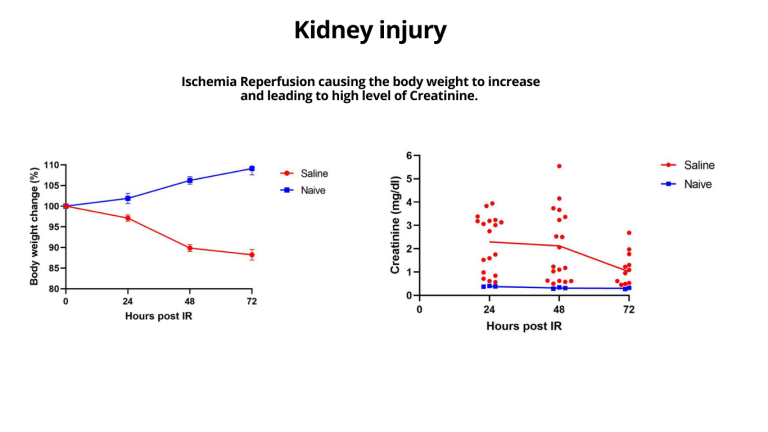Acute kidney injury (AKI) is a condition characterized by a rapid decline in renal function over several days. This results in an accumulation of waste products in the blood and a reduction in urine output. Causes may be prerenal (dehydration, heart failure), intrarenal (glomerulonephritis, acute tubular necrosis, acute interstitial nephritis), or postrenal (urinary tract obstruction). Patients may present with fatigue, nausea, arrhythmia, or fluid balance abnormalities, and the condition is associated with significant morbidity and mortality.
Vivox plays a pivotal role in AKI research, utilizing advanced in vivo models and cutting-edge technologies to study its underlying mechanisms. By collaborating with leading nephrology experts, we support the development of innovative therapeutic strategies to improve the diagnosis, management, and outcome of patients with AKI.
The following kidney disease models for drug candidates and nephrology research are available at Vivox:
Our services support a variety of therapeutic areas

Microbiome

Cell & Gene based Therapy

Biological therapy

Cannabis based therapy
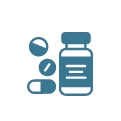
Pharmaceuticals

Nutraceuticals

Medical devices
Acute kidney injuries
Unilateral ureteral obstruction (UUO)-induced kidney fibrosis in mice
Unilateral Ureter Obstruction (UUO) is a commonly used model in preclinical research to study obstructive nephropathy and related diseases of the kidneys. In this model, one ureter is surgically occluded, leading to urinary flow obstruction and subsequent kidney damage.
Vivox utilizes the UUO model in our studies to investigate the pathophysiology of kidney injury, inflammatory responses, renal fibrosis, and potential therapeutic interventions for obstructive nephropathy and related conditions.
Nephrectomy (NX)
Vivox incorporates nephrectomy models into its studies to investigate renal function, disease mechanisms and pathophysiology, and potential therapeutic interventions and their impact on renal health and relevant outcomes.
NX Model
The NX nephrectomy model refers to the surgical removal of one or both kidneys and is commonly used as a model in preclinical research to study renal physiology, kidney diseases, and the efficacy of potential therapeutic interventions.
5/6 Model
The 5/6 nephrectomy model is a surgical procedure that involves the removal of approximately 5/6 (or ~83%) of one kidney and the entire contralateral kidney. This model is commonly used in preclinical research to simulate chronic kidney disease (CKD) or reduced renal function that results from other disease processes.
5/6 Model
The 5/6 nephrectomy model is a surgical procedure that involves the removal of approximately 5/6 (or ~83%) of one kidney and the entire contralateral kidney. This model is commonly used in preclinical research to simulate chronic kidney disease (CKD) or reduced renal function that results from other disease processes.
Ischemia/Reperfusion-Induced Acute Kidney Injury (AKI)
Vivox plays a pivotal role in acute kidney injury (AKI) research by providing advanced in-vivo models and innovative tools for studying ischemia/reperfusion injury. With a multidisciplinary team of experts specializing in renal physiology, imaging technologies, and therapeutic interventions, Vivox contributes to advancing the understanding of AKI pathogenesis and developing targeted treatments to improve patient outcomes.
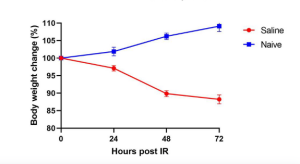
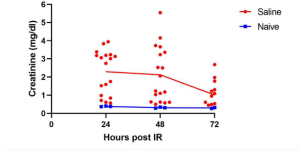
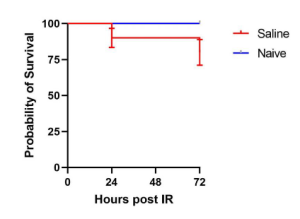
Chronic Kidney Disease (CKD) Model
Chronic kidney diease (CKD) refers to the progressive and irreversible decline in kidney function over time, which leads to the accumulation of waste products and electrolyte and fluid imbalances in the body. This condition can result from various factors such as diabetes, hypertension, Lupus (SLE), and/or glomerulonephritis.
Vivox utilizes CKD models in preclinical research to study the long-term effects of kidney dysfunction, renal fibrosis, metabolic imbalances, and the efficacy of potential therapeutic strategies in slowing disease progression with hopes to improve renal outcomes in chronic kidney disease patients.
Hydrodynamic renal pelvis injection
Special monitoring and physiological systems
Unilateral and bilateral ischemia-reperfusion injury
Research outcomes - examples
